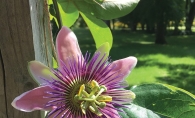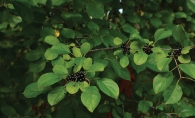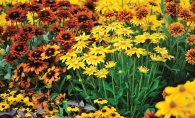Behind the garage or next to the garbage can in the alleys of Macalester Groveland, an unexpected bit of beauty can surprise and delight. It might be a single pot of petunias; it could be a few pepper plants or a row of hostas along a wall. Or it could be a fabulous display of tulips, followed a few weeks later by giant lilies, then finishing off the summer with an abundance of roses. The details don’t matter—what’s important is that a garden along a back fence or garage wall says to friend and potential mischief-maker alike: “Someone has been here, because we care about our neighborhood—even the alleys."
The Alley Garden Awards, sponsored by the Macalester Groveland Community Council, are the motivation for the alley gardens. Started in 1992, the awards were meant to encourage interaction among neighbors and decrease crime.
Liz Boyer, executive director of the Macalester Groveland Community Council, talks about the “big picture” she sees when she looks at the Community Garden Awards. The neighborhood is divided into 17 grids. Volunteer judges sign up for each grid and then walk through the alleys looking for gardens to recognize. And if a grid has a spot without gardens, where graffiti or theft is a problem, other volunteers, like Sarah Cledwyn, may go out and leave a single plant on each front porch with a little card explaining the Alley Garden Awards and encouraging neighbors to participate. One of the reasons the Community Council sponsors the awards is that when neighbors get outside and get to know each other, petty crimes of opportunity decrease. If your neighbors know you, they also know who should be going in and out through your back gate.
Sharon Toscano and her husband Jim are multi-year Alley Garden Award winners. “He’s really the outdoor gardener,” Sharon says, who is also a longtime Alley Garden Award volunteer and the leader of the program for many years. She says the awards started when a member of the neighborhood read about a program in Chicago that had helped improve public safety in a community where petty crime and vandalism had been a problem. Mac-Groveland was struggling with some of those same issues, so the Community Council decided to give it try. It was a big hit from the very beginning. Participation has grown every year, and in 2016 there were just under 700 winners.
Winners are chosen by the volunteers who walk the alleys searching out gardens. Sometimes a neighbor may call the council office and nominate someone, and people are encouraged to nominate their own gardens, too. The volunteers are given training and then work in teams to encourage community building and collaborative judging.
Sharon says the judges aren’t looking to hold the alley gardens to exacting standards. The rules say the entire length of the fence or garage line has to be clean and weed-free. And no matter how beautiful your garden may be, you aren’t eligible for an award unless there is a clearly visible house number on your garage or back fence. Those house numbers make life a lot easier for police and fire fighters in an emergency; public safety workers would love to see house numbers on every garage or back fence in Saint Paul.
The alley gardens have become such a Mac-Groveland tradition that sometimes a whole block gets organized to garden together. Sharon really likes to see an alley that has a garden behind every house. “There are also blocks where everyone helps an elderly neighbor who can’t quite keep the garden up anymore,” she says, noting that is the kind of community the alley gardens are hoping to build. That is one of the other reasons the council loves the awards. Gardens get people out into the alleys, meeting their neighbors and investing in the community.
According to Liz Boyer, the way we use garages and alleys can create neighborhood blind spots “If you back your car out of the garage and come and go through the alley, you might not ever see neighbors on the front the sidewalk,” she says. Alleys haven’t traditionally been thought of as scenic gathering points, like front porches and sidewalks, but “the alley gardens give people an excuse to stop and chat with the neighbor across the alley.” She believes that is how neighbors become friends and maybe begin to talk about other community programs and issues.
Native Garden Awards
The Native Garden Awards were started through the efforts of Craig Skone. Skone, like Sharon Toscano, is a longtime volunteer and has won numerous Alley Awards over the years. In 2008, he brought the idea of a Native Garden Award to the community council and they supported it right away. “So many of our best ideas come from the community,” Boyer says, adding that dedicated, passionate volunteers make the garden awards and so many other programs run.
The Native Garden Awards don’t have as many winners as the Alley Gardens each year. The rules are more specific and a bit more rigorous than the Alley Garden rules, and a gardener has to nominate his or her own garden or be nominated by a neighbor, because unlike the alley gardens, judges can’t always see the native gardens from the other side of the fence.
To qualify for judging in the native garden competition, a garden must be planted with at least 50 percent native plants. The first year, Skone had a master gardener from Ramsey County go with him to look at the entrants. Even with a trained eye, native plants can be hard to distinguish from closely related non-natives. But there weren’t too many gardens to look at that first year and with the Ramsey County master gardener’s help, Skone was able to manage the awards himself. In 2009, however, he wasn’t able to secure the help of a master gardener. Community members Melanie Peterson-Nafziger joined him that year and they’ve been going out on their bikes every year since, seeing what native plants their neighbors are growing. There have been 49 winners since 2008. Skone and Peterson-Nafziger chose them all and gave them the distinctive Native Garden Award. The sign is made from reclaimed materials like soup cans, found beads and repurposed wood. “We wanted something that looked like it belonged in a native garden,” Skone says.
His years of running the program have made Skone very knowledgeable about native plants. Like all gardeners, he’s learned some of what he knows through trial and error. And he will tell you that the program has advanced that way, too. “People need to get used to the idea of native gardens. It’s a different way of doing things,” says Skone. Like all the people involved in the Community Gardens program, he is happy to share knowledge. He’s involved in neighborhood plant swaps and participates every year in the celebration and awards ceremony that the council sponsors to honor the winning gardeners and give them a chance to get to know each other.
Jim Skakoon is a recent Native Garden winner. “I came home one evening and there it was,” he says of his award. “And I said ‘Hey! I won!’ ” Skakoon’s native garden is a serene oasis in the side yard of his house. It runs along the sidewalk, so passing neighbors sometimes stop to ask him about it.
“People want to know if it’s a lot of work. But it really isn’t. These plants know how to take care of themselves. And it’s definitely less work than mowing a lawn,” says Skakoon. He has butterflies and chickadees visiting, along with the neighbors. This brings the Native Garden program back around to the motivation that started the Alley Garden program—getting people outside and talking to each other.









